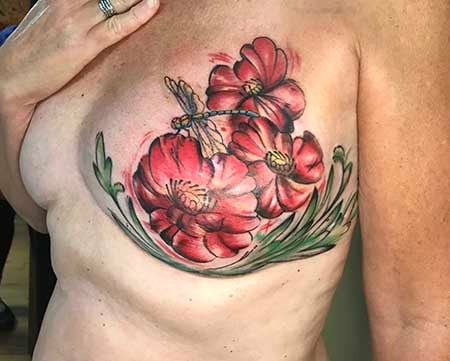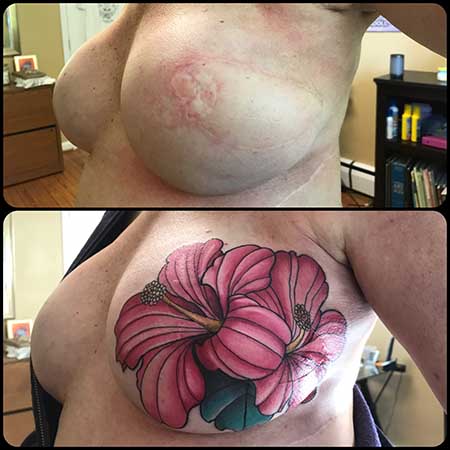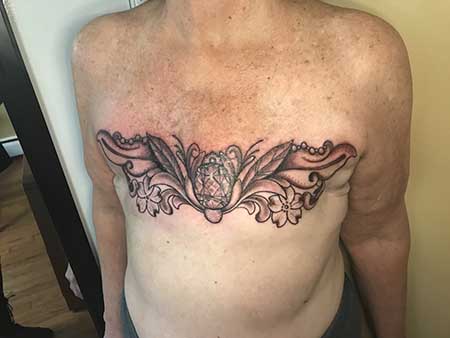Abstract
Tattooing offers expanded possibilities for creative expression for women who have undergone mastectomies and breast reconstruction surgeries. Tattoo techniques for areola restoration, such as repigmentation, do not address breast asymmetry or heavy scarring, but breast tattoos can embolden a woman’s sexuality, self-confidence, and sense of body reclamation, as well as strengthen her postsurgical capacity for relating to her breasts and expressing her identity. There are many factors involved when a tattoo artist is asked to design an image for a patient. This article describes how I apply my artistic and trade talent to help mastectomy patients creatively reach beyond the limitations of surgical reconstruction possibilities.
Introduction
Breast reconstruction is typically the last stage of a course of breast cancer treatment. As women attempt to re-enter the life they knew before diagnosis and treatment, they have time to consider how changes in the physical appearance of their breasts can deeply emotionally influence their lives. In many cases, the results of reconstruction are not aesthetically ideal and leave some women with uneven breasts and the loss of one or both nipples. In my experience, these realities push some women to opt out of reconstruction entirely. Fortunately, through tattooing, there are expanded possibilities to help these women assume more control of the appearance of their breasts.
What Postsurgical Tattoos Can Offer
Areola restoration has traditionally been the “go-to” route for finalizing breast reconstruction. The process involves tattooing a nipple on the reconstructed breast. Unfortunately, the patient can be left with undesirable results that lack realism and fade quickly due to poor technique and incorrect color [1]. Surgical reconstruction can also leave unwanted breast asymmetry or heavy scarring unaddressed, which leads some women to seek my help. Having a personalized tattoo created instead of or in addition to reconstruction allows the woman to take control of what is happening to her body. When a cancer diagnosis takes that feeling of control away, it can be a liberating feeling to the client to end her journey and battle by marking her milestone and expressing her individuality by getting a tattoo over the chest area. Instead of looking in the mirror and seeing what she feels is a negative change to her body, she can gain an improved self-image with the positive addition of a tattoo [2].
Tattoo Design
Traditional body artists are able to offer designs that complement the new landscape of a woman’s postsurgical breasts. Clients are provided with bolder body art design options as opportunities for artistic expression to further their recovery. The possibilities are endless to fit new contours and camouflage scars. The tattoo designs are expansive, ornate, and organic (as seen in figure 1) to best fit the flow of a woman’s body, and they can be used to pull an observer’s eye away from surgical scarring, skin puckering, and asymmetry. With these options available, a woman can use a tattoo creation to embolden her sexuality and self-confidence. Awareness of these alternatives seems to have been spread by various nonprofit groups, including on their social media pages [3].
Figure 1. Unilateral Watercolor Floral Mastectomy Tattoo

Rose Red Tattoo
My personal involvement in breast reconstruction tattooing started in 2014. I had been involved in traditional body art tattooing since 2011, but I wanted to further my education and skillset by receiving permanent makeup training. Permanent makeup is the tattooing of eyebrows, eyeliner, and lip color to mimic the look of makeup and eyebrow hair. It was during this training that I learned areola restoration (using color, light, and shadow to mimic the image of a nipple), other basic tattooing techniques, and how better to work with scarred, radiated, or otherwise damaged skin. With this knowledge, I was inspired to use my trade and artistic talent to reach beyond convention and specialize in tattooing over mastectomies and reconstructed breasts. I opened my own studio, Rose Red Tattoo and Permanent Makeup, in September 2014 to control the environment for my clients, ensuring that they had a professional and comfortable atmosphere. I perform all areola restoration and mastectomy-related tattoo work personally at this location. I have supplemented my training, and I continually network with members of body art professional organizations to further hone my skills. My artistic vision is to help each woman express herself on her own terms and to complement the flow of each woman’s form.
Art on Skin
There are many factors involved when an artist is tasked with designing an image. The quality of the surface is of key consideration. Thought needs to be given, for example, to whether and how a woman’s skin has been damaged by illness or treatment. In some cases, nerve damage can be involved or there are skin and tissue grafts from other parts of the body that complete the breast. Radiation and medications can change a client’s body chemistry and how her skin reacts to the tattoo process. All these things can influence a person’s mental and bodily responses to tattooing, which is actually an abrasion process of repeatedly inserting needles into the dermal layer to inject pigment. Importantly, abrading can trigger a body’s immune and inflammatory responses, which can affect how pigment gets absorbed. One must also keep in mind the skin’s and body’s abilities to heal and retain pigment. Due to considerations like these, some skin areas retain more pigment than others. Some clients, for example, might need multiple sessions to color one area, and some who suffer from many of the aforementioned afflictions might not be good candidates for tattooing at all. For each woman, I assess whether and how a tattoo process could work.
Being versatile as a tattoo artist helps me serve a broad range of women whose style interests are diverse. Design choices are just as important as assessing whether a woman’s skin is healthy enough—whether her scars are mature enough to tolerate tattooing [4]. If a woman’s breasts have an obvious asymmetry (difference in size, bulges, indents, or scar lines, for example), the design needs to rely on light, shadow, and flow to trick an observer’s eye into perceiving those areas differently. Not all design options do this equally well, and a poor design choice could accent the very areas a client wants diminished. So another important dimension of my role in working with woman is to help shape her expectations of what images might look like on her breasts.
Working with Expectations, Design Preferences, and Sculptural Technique
Some clients are not willing to budge from certain themes and imagery that simply do not work with the shape and size of their breasts. While there is some room for compromise, it is important that the shape and flow of the tattoo remain intact so that the work remains cohesive when viewed from, say, a mirror. I often talk with clients about how large or small they want a design to be. Also, I must help them consider an image’s effect before it’s actually on their skin; this is not just about placing a design that merely covers an undesirable area but about creating one that optically—considering light and shadow, for example—blends and smooths that area. If I acquiesced to a client’s specific demands without sufficient discussion, the success of the tattoo could be compromised, leaving yet another unwanted mark on her body and resulting in her disappointment. So I see the stakes of my work as high because of my work’s permanence. With this in mind, in some cases, the best thing I can do for some clients is to deny the service and explain why I probably cannot meet their expectations.
Figure 2. Unilateral Hibiscus Flower Mastectomy Tattoo on Reconstructed Chest

Design Process for a Reconstructed Chest
As seen in Figure 2, the client wanted a unilateral design for her left breast. She told me she wanted a design that would cover the incision scars and the nipple the surgeon tried to recreate. She expressed that she felt a deep connection to Hawaii, and so the hibiscus flower, native to the islands, was chosen. Floral subjects in general often are excellent choices to cover scars as their organic forms allow for flexibility in either pulling the eye away from the unwanted skin texture or incorporating that texture into the image. I placed the middle of the hibiscus flower over the unwanted nipple area and the flower’s stamen pointing towards the inside of the body to help hide the skin texture. I then used one of the petals of the same flower to fill the space left by the incision scars. This petal and the second flower behind it helped to further blend color, light, and shadow to hide the client’s skin. The client was not concerned with scarring along the ribs or under the breast, so those areas were left alone. Her skin and scarring accepted the tattoo process well and I was able to create a vivid and vibrant full-color image without much resistance.
Design Process for Unreconstructed Chest
As seen in Figure 3, the client opted out of reconstruction. She was in her 60s and had sun damage on her chest. Age and sun exposure affect the skin’s elasticity and degrade skin texture [5]. There was also skin folding and puckering on the sides of her chest. The client asked for a black and gray feminine design but was not interested in animal imagery or a large floral. I created an ornamental design with leafy filigree, a jewel, and small flowers. I placed it lower on the chest to avoid most of the sun damaged area. There is a stark difference between the tattooing of the sun damaged areas at the top of her chest and the paler healthier skin at the bottom. The top is more red and swollen from irritation directly after the procedure, which is attributable to the maturity and sun damage. Slight pigment migration under the skin is also to be expected, as the dermal layer’s matrix is not as strong as the healthier skin below. The skin’s irritation will subside, but its presence tells the story of the skin’s state. By putting a jewel in the middle, I pulled the focal point away from the puckered skin and scars, while the leaves and filigree give the client the coverage of a thin band-like garment.
Figure 3. Black and Gray Ornamentation Mastectomy Tattoo on Unreconstructed Chest

Conclusion
Being a woman and an artist, I pay close attention to the psychology of body image and perception. From diagnosis to reconstruction, women who’ve been treated for breast cancer go through a long journey and want to reclaim some control over what happens to their body. Having a skilled artist help complete that journey gives them some control and enhances their capacity to pursue a positive image that surgery alone cannot do. When both processes of surgical reconstruction and artistic tattooing come together harmoniously, a beautiful work of art is created for the women that lasts a lifetime.
References
-
Kelly M. For better nipple reconstruction in cancer patients, surgeons turn to tattoo artists. Live Science. June 4, 2014. https://www.livescience.com/46093-nipple-reconstruction-surgeons-tattoo-artists.html. Accessed January 14, 2018.
-
Laura. The psychology of body modification. Painful Pleasures. https://info.painfulpleasures.com/blogs/psychology-body-modification. Published March 20, 2015. Accessed January 14, 2018.
-
P.ink website. http://p-ink.org/. Accessed February 6, 2018.
-
ASCO (American Society of Clinical Oncology) Cancer.Net. Side effects of radiation therapy. https://www.cancer.net/navigating-cancer-care/how-cancer-treated/radiation-therapy/side-effects-radiation-therapy. Published December 2016. Accessed January 14, 2018.
-
Cosmetic procedures: sun exposure and skin cancer. WebMD. https://www.webmd.com/beauty/sun-exposure-skin-cancer#1. Accessed January 14, 2018.



